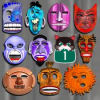 As I’ve gotten older, my eyesight has deteriorated to the point I need glasses. When you wear glasses, you become acutely aware how the lens you see something through affects how you look at that object. This lunchtime post brings together a few articles and topics, all about how the lens you view through changes your perception:
As I’ve gotten older, my eyesight has deteriorated to the point I need glasses. When you wear glasses, you become acutely aware how the lens you see something through affects how you look at that object. This lunchtime post brings together a few articles and topics, all about how the lens you view through changes your perception:
- Our View of the World. Most of us have our idea of the spatial relationships of the world from the Mercator Projection map, which goes back to 1589. This map was designed for navagators, and it was important to get where the countries were in relation to each other. Size and proportion, less so. Realize that any map is a projection, taking a portion or the entirety of a spherical surface, and making it flat. The distortions may be minor when this is done for a city, increase as you move from a state to the country, and are magnified for the world. The Mercator is a particularly bad projection. As Wikipedia notes: “It became the standard map projection for nautical purposes because of its ability to represent lines of constant course, known as rhumb lines or loxodromes, as straight segments that conserve the angles with the meridians. Although the linear scale is equal in all directions around any point, thus preserving the angles and the shapes of small objects (which makes the projection conformal), the Mercator projection distorts the size of objects as the latitude increases from the Equator to the poles, where the scale becomes infinite. So, for example, landmasses such as Greenland and Antarctica appear much larger than they actually are relative to land masses near the equator, such as Central Africa.” This also means that the size of *white* areas — Europe, Russia, America — are enlarged and the size of non-white areas are smaller. This can influence one’s understanding of power dynamics, and so some alternate projections have come in the news to address this. In Boston, they are using the Peters Projection, which stretches out the world in order to give each continent a proportionally accurate amount of room. On the Peters, Canada—so huge on the Mercator—shrinks to its proper size, while Africa, which the Mercator shows shrunk and jammed beneath a too-large Europe, stretches out. In Japan, a design competition has brought us the AuthaGraph Map, where continents curve upward like a smile. Africa and the Americas look like they swapped places, longitude and latitude are no longer a tidy grid, and proportions of continents and bodies of water are retained. All of these cause discomfort for Euro-centra or America-centric — really, white centric — for they emphasize the reality of the smallness of Europe and America.
- Transit Maps. No article here, but a similar distortion of view comes from transit maps. Transit maps are often drawn stylized, showing stations in relationship to each other, but with a grid that may not accurately reflect the distance between stations, or how stations relate to the geography of the city. This can often result in travelers believing a distance is walkable when it isn’t.
- The Meaning of Art. We tend to believe that the meaning of an artwork is independent from where that artwork is located. But that’s not always true. Consider the “Fearless Girl” statue in NYC. This statue — which was part of an advertising campaign — was placed in proximity to the private artwork “Charging Bull”. This bothered the artist behind bull as it changed the meaning of his piece… and the location was specifically chosen by the “girl” artist because of the meaning the bull gives. But, as the article points out, replace the bull with a group of immigrant families, and the meaning completely changed. “Girl” is a piece that gains meaning from its surroundings.
- Men’s Magazines. The LA Times recently had an article on the attempted rebirth/resurgence of Penthouse Magazine. But what caught my eye was one exchange: «“I don’t wish the bunny ill,” Holland said. “But I’ve seen it make bad decisions for so long.” She cited Playboy’s decision two years ago to stop running nude photos in its magazine, only to reverse that decision earlier this year. “We are defined by Playboy and Playboy is defined by us,” she said. “I respect iconic brands.”» Penthouse is defined by Playboy. Playboy was borderline acceptable; Penthouse when across the line to raunchy, and Huster went to the strip club around the corner. A fascinating definition, but quite common. Look at Conservative Judaism. Rarely is it defined for what it is, but that it is somewhere in the middle between Orthodox and Reform. Again, we are defined by what is around us.
Can you think of additional examples?

